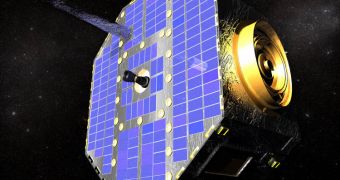Researchers at the American space agency say that the latest investigation of the galactic wind has revealed a chemical composition that appears to be alien. In other words, these winds are not made of the same particles as the solar system.
The discovery was made using the NASA Interstellar Boundary Explorer (IBEX) spacecraft, which is located in a Sun-oriented, spin-stabilized orbit round the planet. Its mission is to use the onboard energetic neutral atom (ENA) imagers to determine the boundaries of the solar system.
As the Sun conducts nuclear fusion, it releases charged particles that spread in all directions. These particles create a giant magnetic bubble of sorts, called the heliosphere. The boundaries of this construct are called the heliosheath.
They occur where the pressure of charged particles released from the Sun is equated by the intensity of galactic winds. Even then, particles streaming through the Milky Way are prevented from penetrating into the Sun's surroundings.
However, this is not true for neutrally-charged particles, which pass through this barrier without a problem. They spend the next 30 years traveling the 7.5 billion miles (12 billion kilometers) that separate the heliosheath from the Sun, and then slingshot around the star.
IBEX is placed in such a manner that it can accurately detect these incoming particles, and construct a view of how the edge of the solar system looks like, based on that data. The Small Observatories mission conducts a full survey of the sky every year, and completed 3 thus far.
“We've directly measured four separate types of atoms from interstellar space and the composition just doesn't match up with what we see in the solar system,” IBEX mission scientist Eric Christian explains.
“IBEX's observations shed a whole new light on the mysterious zone where the solar system ends and interstellar space begins,” adds the expert, who is based at the NASA Goddard Space Flight Center (GSFC), in Greenbelt, Maryland.
Details of the investigation appear in the January 31 issue of the esteemed Astrophysics Journal. One of the most important conclusions is that any portion of our solar system has more oxygen than the interstellar medium.
The galactic wind displays 74 oxygen atoms for every 20 neon atoms, whereas the solar system contains 111 oxygen atoms for every 20 neon ones. “Our solar system is different than the space right outside it and that suggests two possibilities,” David McComas explains.
“Either the solar system evolved in a separate, more oxygen-rich part of the galaxy than where we currently reside or a great deal of critical, life-giving oxygen lies trapped in interstellar dust grains or ices, unable to move freely throughout space,” adds the expert.
McComas is the principal investigators of the IBEX mission, and is based at the Southwest Research Institute (SwRI), in San Antonio, Texas.

 14 DAY TRIAL //
14 DAY TRIAL //